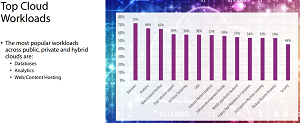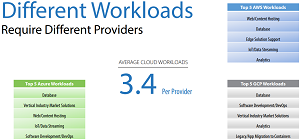News
Research Shows Cloud Workloads Vary by Platform, but Data Rules
TECHnalysis Research's new report on cloud computing finds that workloads vary across platforms -- AWS, Azure, GCP -- but databases are at the forefront.
Furthermore, those database workloads are spread across a cloudscape fairly evenly divided among the top enterprise options, public cloud, on-premises legacy and private/hybrid cloud, says the report, which was conducted with the aim of determining cloud platform and workload usage and reasons why they're used.
"What the study found is that for companies like those surveyed, who have been using cloud computing for several years now, approximately 30 percent of today's workloads are being run in the public cloud, another 30 percent are legacy applications still being run in the corporate data center, and the remaining 40 percent are a combination of private and hybrid cloud workloads," said Bob O'Donnell, company president, in a Jan 14. blog post titled "New Research Shows It's a Hybrid and Multi-Cloud World."
Those referenced companies include some 600 medium and large U.S.-based businesses who were users of cloud computing and who responded to an online survey.
The cloud workloads summary breaks down cloud approaches used by respondents like this:
- Public cloud: 40 percent
- On-premises legacy: 31 percent
- Private/hybrid cloud: 29 percent
The most popular workloads across all three approaches are: databases, analytics and web/content hosting, as shown here:
 [Click on image for larger view.] Top Cloud Workloads (source: TECHnalysis Research).
[Click on image for larger view.] Top Cloud Workloads (source: TECHnalysis Research).
One interesting finding is that the mix of cloud workloads varies by provider, with the top three being Microsoft Azure, Amazon Web Services (AWS) and Google Cloud Platform (GCP). For example, while databases are No. 1 on Azure and GCP, the top workload on AWS is web/content hosting, as shown here:
 [Click on image for larger view.] Workloads By Provider (source: TECHnalysis Research).
[Click on image for larger view.] Workloads By Provider (source: TECHnalysis Research).
Other key takeaways from the report include:
- It's a multi-cloud world: the average number of cloud providers is 2.3 for Infrastructure-as-a-Service (IaaS) and 2 for Platform-as-a-Service (PaaS), for a 3.1 average number of cloud providers.
- Top SaaS applications: Microsoft Office 365 (68 percent of respondents); Microsoft SharePoint (42 percent); Google G Suite (37 percent).
- Top cloud platforms: Azure (72 percent); AWS (53 percent); GCP (53 percent); IBM (47 percent).
- Top factors in selecting cloud providers (no percentages given): quality of management tools; quality of programming tools; price.
- Top reasons for abandoning a project: bad experience (43.7 percent); poor quality programming tools (43 percent); poor quality management tools (40.8 percent).
- Top reasons for moving to cloud: performance improvements (36 percent); cost savings (32.9 percent); create new products or services (31.8 percent).
- Top reasons for not moving to cloud: security (52.5 percent); regulatory requirements (43.7 percent); lack of internal development skills (42.3 percent).
Speaking of the latter two findings, O'Donnell said, "The top reasons that survey respondents gave for migrating workloads to the cloud are to improve performance, to increase security, and because of the need to modernize applications. Cost savings actually came in fourth. Ironically, the top reasons those same companies cited for not moving some of their applications to the cloud were very similar: security concerns, performance challenges, regulatory requirements and costs. These dichotomies highlight the ongoing challenges and opposing forces that are a regular part of the modern cloud computing landscape."
More information can be found in O'Donnell's post, which includes a link to a free preview of the for-pay report.
About the Author
David Ramel is an editor and writer for Converge360.